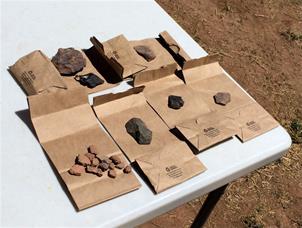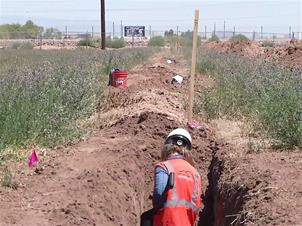Environmental stewardship key in preparing path for South Mountain Freeway
Environmental stewardship key in preparing path for South Mountain Freeway
PHOENIX – Along the 22-mile corridor where the South Mountain Freeway will be built over the next few years, archaeologists are working to gather and recover items and information from the past that may have cultural or historic significance.
At one point along the freeway footprint, archaeologists are systematically digging 5-foot-deep trenches looking for signs that ancient people lived or farmed there. At other sites, archaeologists have found pottery pieces and 19th-century shotgun shells, among other items, and also documented historic petroglyphs.
Whether they contain evidence of those who inhabited this area in prehistoric times, artifacts from farms important to the area’s heritage or even an abandoned railroad, these sites must be managed according to federal and state historic preservation laws before freeway construction begins this summer.

“Protecting and preserving cultural resources is the law, but it’s also the right and respectful thing to do,” said Linda Davis, who leads ADOT’s Historic Preservation Team.
By law, some of this work must remain confidential while it is happening, and sometimes a site will be fenced and monitored by security for safety reasons and to protect what ADOT’s research and field surveys suggest may be found there.
Federal and state regulations require ADOT and the Federal Highway Administration to identify and address any potential environmental impacts that could affect cultural or historic resources, air and water quality, wildlife, noise levels, hazardous waste and more before proceeding with any construction project.
This makes the agency one of the largest sponsors of archaeological research in Arizona. As part of its environmental planning process, the agency considers the effects of transportation projects on sensitive cultural resources by consulting with Native American communities, conducting research and limiting impacts from highway construction as much as possible.
When a site is determined to have historic or cultural significance, ADOT’s Historic Preservation Team develops a plan, in consultation with tribal leaders, tribal historic preservation officers, state historic preservation offices, land managers and other stakeholders to minimize harm from construction. At a site where construction will occur, archaeologists will gather items and information, a process referred to as data recovery.

“Building any transportation facility has consequences, including cultural and environmental impacts that ADOT is committed to minimizing as much as possible,” ADOT Director John Halikowski said. “In fulfilling its environmental commitments, including how it handles cultural resources, ADOT has to strike a balance between the need for a modern transportation network and protecting Arizona’s cultural heritage.”
The South Mountain Freeway, which will run east and west along Pecos Road and then north and south near 59th Avenue, connecting with Interstate 10 on each end, is expected to open by late 2019. The freeway will provide a long-planned direct link between the East Valley and West Valley and a much-needed alternative to Interstate 10 through downtown Phoenix. Approved twice by Maricopa County voters, the South Mountain Freeway will complete the metropolitan area loop freeway system.
Construction is scheduled to begin in summer 2016. Preliminary engineering, including geotechnical and utility work, and property acquisition and preparation, have been underway since spring 2015 after ADOT received final federal clearance to move forward.
For more information, visit azdot.gov/SouthMountainFreeway.
